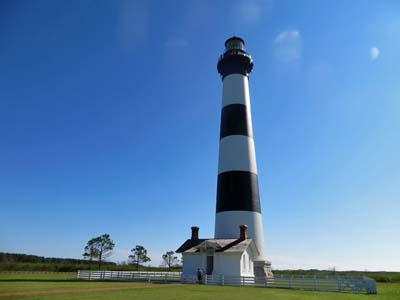This year, for the first time, visitors can climb the Bodie Lighthouse at Cape Hatteras National Seashore.
The lighthouse has been standing on Oregon Inlet in the Outer Banks since 1872, still with its original first-order (largest, most powerful, and expensive) Fresnel lens. The striped lighthouse is 165 feet tall, shorter than the one down the coast at Cape Hatteras (198.49 feet), its more famous cousin. But the Bodie Lighthouse offers something that the Hatteras Lighthouse doesn’t have: a guided tour given by an enthusiastic ranger.
Climbing the Lighthouse
A ranger can take up to 22 people on the 45-minute tour. Ranger Joel Proper first assembled us in a room at the bottom of the lighthouse where he asked children the reason for lighthouses.
“Imagine my feet are Florida, my waist is Charleston,” he explained as he used his body to go up the Eastern Seaboard. Then he stuck his elbow out, “and this is Cape Hatteras. Warm air goes up the coast. In the meantime, cold water is coming down from Canada. Where they meet is known as the Graveyard of the Atlantic," a region where shallow waters and converging currents make for tricky sailing and navigation.
Lighthouses were built and staffed to guide sailors around these treacherous waters with their strong beaming signals. “But a lighthouse also told mariners that they weren’t alone. Someone cared about them,” the ranger added.
Our group started climbing. The staircase is freestanding, not bolted to the wall. Even after a lot of studies, the park staff is not quite sure how much weight it can hold.
"After all", Ranger Proper pointed out, "the staircase was designed for one man going up to the top twice a day."
The 214 steps are divided into seven cast-iron landings. Every second landing, Ranger Proper stopped to let everyone catch up. Some visitors also needed to catch their breath. He took the opportunity to tell the history of the lighthouse and to answer questions.
“Why are there guided tours here and not at the Cape Hatteras lighthouse?” I asked.
“The steps are wider at Cape Hatteras and people can pass each other. Here there’s no passing. Also, it’s our first year giving tours. Maybe things will change.”
Once we got to the top, the group was speechless, and not because we were worn out. The view is, well, breathless. As we walked around the outside viewing deck, Ranger Proper oriented us to the ocean east and sound side to the west.
“Way out there, beyond the ocean, you can see England,” he joked.
Before the area became a national seashore, the local duck club dammed up the small streams to create ponds. The brackish water attracts waterfowls and, back then, hunters to shoot them. The National Park Service has left the dam and duck ponds in place. Now the area attracts birders, photographers, and even hunters by reservation. To help negotiate the marshy area, park crews built a walkway and observation platform.
Though we were guided to the top of the lighthouse, we were free to spend as much time on top as we wanted and come down at our own pace.
A Little History
The current lighthouse actually is the third Bodie Lighthouse. The first one, built in 1847, leaned so much that its lamps were out of synch. After ten years, it was declared useless.
The second lighthouse was built just before the Civil War. After Federal troops captured the Outer Banks in 1862, retreating Confederates removed the lens and blew up the lighthouse, leaving the area in total darkness. Both previous lighthouses are now underwater. On our tour, the ranger showed us where you could see a bump, way out in Oregon Inlet, where the first lighthouse sank.
The current lighthouse is north of Oregon Inlet, halfway between the ocean and the sound. The previous owner of the lighthouse and lens, the U.S. Coast Guard, wasn’t so sure it wanted to give up the lighthouse and, more importantly, the lens. The transfer of the complete site to the National Park Service occurred only in 2005.
Plans for restoration of the lighthouse started almost immediately after that. But there were lots of setbacks. Federal funding was requested but not received. Once renovations started, they found significant structural problems, requiring more money. But hopefully this is all behind us. Visitors can now climb the lighthouse.
Body or Bodie?
Spelling was more fluid in the past than it is now. The name of the island has changed spelling over the years. It used to be Body but now is Bodie. But a sign in the visitor center is adamant that the pronunciation is “body”. A marble plaque high up the wall just before you start the climb says:
Body’s Island Lighthouse
Erected A.D. 1872
Latitude 35 – 48
Longitude 75 - 33
A Search for Descendants
The Bodie Island Lighthouse Society is planning a homecoming for direct descendants of Bodie Island Lighthouse Keepers on October 18-18, 2013, after the lighthouse closes to visitors for the season. If you’re a direct descendant, you need to fill out a form. This homecoming is organized by Cheryl Shelton-Roberts, who with her husband, write books about the Outer Banks. See the press release for all the details.
Touring the Bodie Lighthouse
Tours are offered every day through Columbus Day, Monday October 14. Tours start every 35 minutes and last 45 minutes. The price is $8 for adults, $4 for seniors. Half the tours are available by advance reservations, the other half only on the day. All the rules and regs are here.
So the standard advice applies: wear good sneakers (not flip-flops) and carry a bottle of water—there’s no air conditioning. And plan to get to Bodie Lighthouse and climb early in the day. The bookstore offers a certificate for this “great feat”. I climbed the Bodie Lighthouse. No, no t-shirts, yet.


 Support Essential Coverage of Essential Places
Support Essential Coverage of Essential Places






